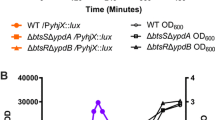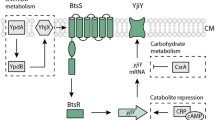Abstract
Several species of enterobacteria are able to utilize citrate as carbon and energy source. Under oxic conditions in the presence of a functional tricarboxylic acid cycle, growth on this compound solely depends on an appropriate transport system. During anaerobiosis, when 2-oxoglutarate dehydrogenase is repressed, some species such as Klebsiella pneumoniae and Salmonella typhimurium, but not Escherichia coli, are capable of growth on citrate by a Na+-dependent pathway forming acetate, formate, and CO2 as products. During the last decade, several novel features associated with this type of fermentation have been discovered in K. pneumoniae. The biotin protein oxaloacetate decarboxylase, one of the key enzymes of the pathway besides citrate lyase, is a Na+ pump. Recently it has been shown that the proton required for the decarboxylation of carboxybiotin is taken up from the side to which Na+ ions are pumped, and a membrane-embedded aspartate residue that is probably involved both in Na+ and in H+ transport was identified. The Na+ gradient established by oxaloacetate decarboxylase drives citrate uptake via CitS, a homodimeric carrier protein with a simultaneous-type reaction mechanism, and NADH formation by reversed electron transfer involving formate dehydrogenase, quinone, and a Na+-dependent NADH:quinone oxidoreductase. All enzymes specifically required for citrate fermentation are induced under anoxic conditions in the presence of citrate and Na+ ions. The corresponding genes form a cluster on the chromosome and are organized as two divergently transcribed operons. Their co-ordinate expression is dependent on a two-component system consisting of the sensor kinase CitA and the response regulator CitB. The citAB genes are part of the cluster and are positively autoregulated. In addition to CitA/CitB, the cAMP receptor protein (Crp) is involved in the regulation of the citrate fermentation enzymes, subjecting them to catabolite repression.
Similar content being viewed by others
Author information
Authors and Affiliations
Additional information
Received: 25 September 1996 / Accepted: 18 November 1996
Rights and permissions
About this article
Cite this article
Bott, M. Anaerobic citrate metabolism and its regulation in enterobacteria. Arch Microbiol 167, 78–88 (1997). https://doi.org/10.1007/s002030050419
Issue Date:
DOI: https://doi.org/10.1007/s002030050419




